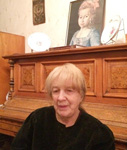звоните: +7 495 204-207-8
e-mail: art@quartagallery.ru
Nikitina Ludmila

Ludmila Nikitina was born in 1927 in Leningrad, the city which her creative activity has continuously been connected with despite her living in Moscow for a long time. She entered the art school there attached to the USSR Academy of Arts and later graduated from Vera Mukhina Higher School of Art and Design in 1954. Afterwards she decided to go on with her artistic education at the Moscow Institute of Applied and Decorative Arts. The artist's family was tightly connected with the theater, especially with the opera. An immense influence on her creative activity was her attachment to poetry, in particular that of А.S. Pushkin and Alexander Blok, and their specific vision of Petersburg.
The city of her childhood and youth occupies a significant place in the artist's creativity: its palaces, gardens, channels and bridges wrapped up in mysterious mist frequently appear on her canvases. Besides Petersburg, Ludmila Nikitina paints the landscapes of small Russian towns, such as Pereslavl-Zalessky, Myshkin, Kirzhach, Totma and Vologda. For many years the artist travelled around these ancient Russian cities. Nikitina's art leads us to the poetic perception of the “city" and “city landscape" rather than the realistic one, as, for instance, in one of her most well-known series “White Nights" recreating the phantasmal atmosphere of Petersburg.
As it was noted by the Doctor of Arts, member-correspondent of the Russian Academy of Sciences and reputable expert in ancient Russian art G.I. Vzdornov: “The brilliant feature of Nikitina's artworks is their topographic indefiniteness. She is not keen on the architectural subjects and attractive angles, it is not the subject that captures Nikitina's attention but the state of the soul of the selected motif: the humidity of air, the summer day's heat, the decay of the buildings, their combination with old trees, willows thoughtfully leaning towards water, their reflection and the reflection of the houses on the lake or river surface, the weirdness of the city landscape created not by the architect's will but by the natural course of time.»
Ludmila Nikitina has mastered various techniques but most of all she is fond of pastels, which is a complicated technique providing an incredible effect. Few modern artists employ this technique as broadly as Nikitina. She uses it as the main technical means to express her artistic ideas and, since she prefers large formats, her pastels create an impression of genuine paintings.
Ludmila Nikitina's artworks are presented at the State Russian Museum, All - Russian Decorative - Applied and Folk Art Museum, at the art museums and galleries and private collections of Russia, France, Holland, Japan and USA.
